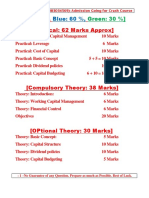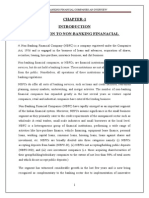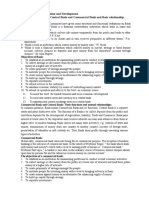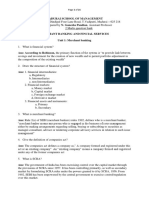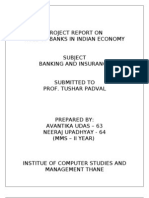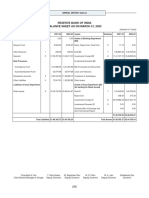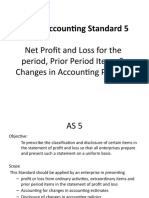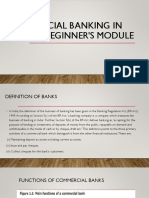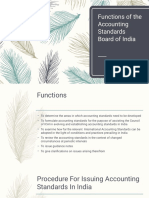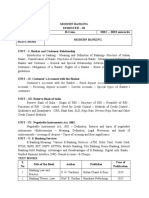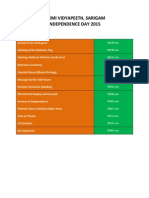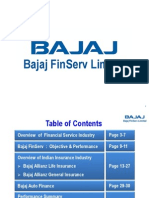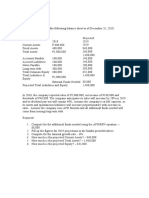MARWADI UNIVERSITY
Faculty of Liberal Studies Enroll. No._________
[ B.com ]
[Indian Financial System] SEM: 3 WINTER-2019
__________________________________________________________________________
Subject: - (Indian Financial System) (04BC0306) Date:-22/11/2019
Total Marks:-100 Time: - 03:00 hours
Instructions:
1. All Questions are Compulsory.
2. Make suitable assumptions wherever necessary.
3. Figures to the right indicate full marks.
Question: 1.
(a) Objective MCQ [10]
(1) In India, Banking function is centrally controlled and governed by
(i) SBI
(ii) Central Bank of India
(iii) RBI
(iv) SEBI
(2) RBI started functioning on
(i) 1-4-1935
(ii) 1-4-1948
(iii) 1-4-1882
(iv) 1-4-1945
(3) The oldest stock exchange in India is
(i) Bombay Stock Exchange
(ii) National Stock Exchange
(iii) Saurashtra & Kutch Stock Exchange
(iv) Ahmadabad Stock Exchange
(4) The basic regulatory authority for Stock Market & Mutual fund lies with the:
(i) Stock exchanges
(ii) RBI
(iii) NABARD
(iv) SEBI
(5) What are Gilt-edged Securities in India ?
(i) Securities issued by the Government
(ii) Securities issued by the Private Sector companies
(iii) Securities issued by the Multinationals
(iv) None of the above
(6) NIFTY carries
(i) Top 50 companies from India
(ii) Top 50 companies listed on NSE
(iii) Top 30 companies listed on BSE
(iv) All of the above
MARWADI UNIVERSITY 1|
� Enroll. No._________
(7) A stock market is a place where
(i) Stock buyers & sellers meet
(ii) Investors & companies meet
(iii) Traders & companies meet
(iv) RBI & SEBI meet
(8) Convertible Bonds are
(i) Equity instruments
(ii) Debt instruments
(iii) Hybrid instruments
(iv) Bank notes
(9) Money loaned by a bank or other institution which is repayable on demand called
(i) Risk premium
(ii) Capital receipt
(iii) Bank loan
(iv) Call Money
(10) The risk-return tradeoff states that:
(i) Investment in shares with low brokerages
(ii) NBFC’s investment
(iii) The potential return rises with an increase in risk
(iv) None of the above
(v) Short Que. (answer in one sentence) [10]
(1) What is Money Market?
Ans. a component of the economy which provides short-term funds. The money market deals in short-term
loans, generally for a period of less than or equal to 365 days.
(2) What is Mutual fund?
Ans. A mutual fund is a professionally managed investment fund that pools money from many investors to
purchase securities.
(3) Who is a basic regulator for Insurance companies?
Ans. IRDA
(4) What is secondary market?
Ans. Already issued shares and securities are listed for trading and exchange between investors
(5) What is T-bill?
Ans. Trasurry Bill. Treasury Bills are short term (up to one year) borrowing instruments of the Government
of India which enable investors to park their short term surplus funds while reducing their market risk.
(6) What it stands for OTCEI?
Ans. Over- the- counter Exchange of India
(7) What do you mean by an IPO?
Ans. Initial Public Offering
(8) What are the types of Financial Derivative Instruments?
Ans. Future, Forward, Options-call & Put
(9) What is India's largest custodian and depository participant?
Ans. SHCIL-Stock Holding Corporation of India Ltd.
(10) What is a dividend?
Ans. Dividend refers to a reward, cash or otherwise, that a company gives to its shareholders. Dividend is
usually a part of the profit that the company shares with its shareholders.
MARWADI UNIVERSITY 2|
� Enroll. No._________
Question: 2.
(a) Explain about Indian financial System, both organized and unorganized system. [08]
Ans. Organized Institutions and lenders. Network of banks, other financial institutions and investment
institutions
Unorganized Money lender, Pawn brokers, traders
(b) Write a note on IRDA. [08]
Ans. Insurance Regularoy development authority
he Insurance Regulatory and Development Authority of India (IRDAI) is an autonomous, statutory
body tasked with regulating and promoting the insurance and re-insurance industries in India.[1] It was
constituted by the Insurance Regulatory and Development Authority Act, 1999, [2] an Act of Parliament passed
by the Government of India.[3] The agency's headquarters are in Hyderabad, Telangana, where it moved
from Delhi in 2001.[4]
IRDAI is a 10-member body including the chairman, five full-time and four part-time members appointed by
the government of India.
OR
(b) Write a note on SEBI [08]
Ans. Securities Exchange Board of India The Securities and Exchange Board of India is the Regulator for the
Securities market in India owned by Government of India. It was established in 1988 and given Statutory
Powers on 30 January 1992 through the SEBI Act, 1992
Question: 3.
(a) Explain in detail about depository participants, custodial services and Credit rating agencies. [08]
Ans. Depository Participants: NSDL, CDSL.
Depository Participant (DP) is described as an Agent of the depository. They are the intermediaries between
the depository and the investors. The relationship between the DPs and the depository is governed by an
agreement made between the two under the Depositories Act. In a strictly legal sense, a DP is an entity who is
registered as such with SEBI under the sub section 1A of Section 12 of the SEBI Act. As per the provisions of
this Act, a DP can offer depository-related services only after obtaining a certificate of registration from
SEBI. As of 2012, there were 288 DPs of NSDL and 563 DPs of CDSL registered with SEBI.
A custodian is a financial institution that holds customers' securities for safekeeping in order to minimize the
risk of their theft or loss. A custodian holds securities and other assets in electronic or physical form. Since
they are responsible for the safety of assets and securities that may be worth hundreds of millions or even
billions of dollars, custodians generally tend to be large and reputable firms. A custodian is sometimes
referred to as a "custodian bank.
A credit rating agency (CRA) is a company that rates debtors on the basis of their ability to pay back their
interests and loan amount on time and the probability of them defaulting. These agencies may also analyse the
creditworthiness of debt issuers and provide credit ratings to only organisations and not individuals
consumers.
There are six credit rating agencies registered under SEBI namely, CRISIL, ICRA, CARE, SMERA,
Fitch India and Brickwork Ratings. Ratings provided by these agencies determine the nature and integrals
of the loan. Higher the credit rating, lower is the rate of interest offered to the organisation
MARWADI UNIVERSITY 3|
� Enroll. No._________
(b) Explain about factoring, forfeiting and venture capital financing. [08]
Ans. Factoring is a financial transaction and a type of debtor finance in which a business sells its accounts
receivable (i.e., invoices) to a third party (called a factor) at a discount.[1][2][3] A business will sometimes factor
its receivable assets to meet its present and immediate cash needs.
Types of factoring: Recourse Factoring.
Non Recourse Factoring.
Maturity Factoring.
Advance Factoring.
Invoice Discounting.
Full Factoring.
Bank Participation Factoring.
Domestic and Cross border Factoring.
Forfeiting:-Method of export trade financing, especially when dealing in capital goods (which have
long payment periods) or with high risk countries. In forfeiting, a bank advances cash to an
exporter against invoices or promissory notes guaranteed by the importer's bank. The amount advanced is
always 'without recourse' to the exporter, and is less than the invoice or note amount as it is discounted by the
bank. The discount rates depends on the terms of the invoice/note and the level of the associated risk.
Venture capital financing:- venture capital financing (also known as venture capital funding or
VC funding) is risk-equity investing through funds that are professionally managed and provide seed, early-
stage and later-stage funding to accelerated growth companies
OR
(a) What is Forex market? Explain in detail. [08]
Ans. The foreign exchange market (Forex, FX, or currency market) is a global decentralized or over-the-
counter (OTC) market for the trading of currencies. ... It includes all aspects of buying, selling and
exchanging currencies at current or determined prices.
The main participants in this market are the larger international banks. Financial centers around the world
function as anchors of trading between a wide range of multiple types of buyers and sellers around the clock,
with the exception of weekends.
(b) Explain about Hybrid instrument. [08]
Ans. An investment product that combines the attributes of an equity security with a debt security. ...
Examples of hybrid instruments are convertible bonds, preferred stocks, equity default swaps and structured
notes linked to an equity index. Also called hybrid securities
A hybrid security is a single financial security that combines two or more different financial instruments.
Hybrid securities, often referred to as "hybrids," generally combine both debt and equity characteristics. The
most common type of hybrid security is a convertible bond that has features of an ordinary bond but is
heavily influenced by the price movements of the stock into which it is convertible.
Question: 4.
(a) Enumerate the functions of Commercial Bank. [08]
Ans. The primary functions of a commercial bank are accepting deposits and also lending funds. Deposits
are savings, current, or time deposits. Also, a commercial bank lends funds to its customers in the form of
loans and advances, cash credit, overdraft and discounting of bills, etc
MARWADI UNIVERSITY 4|
� Enroll. No._________
(b) What is the corporate restructuring through Leveraged Buyout [04]
Ans. Corporate restructuring is the comprehensive process by which a company can consolidate its
business operations and strengthen its position for achieving the desired objectives of staying synergetic,
slim, competitive, flexible, profitable & successful and involves significant reorientation, reorganization
or realignment of assets & liabilities of the organization through conscious management action with the
objective of considerably altering the quality & quantity of the future cash flow streams and focus the
company on its main line of business.
A leveraged buyout (LBO) is the acquisition of another company using a significant amount of borrowed
money to meet the cost of acquisition. The assets of the company being acquired are often used as collateral
for the loans, along with the assets of the acquiring company.
(c) What is Bill-discounting? [04]
Ans. Bill discounting is an arrangement whereby the seller recovers an amount of sales bill from the financial
intermediaries before it is due. Such intermediaries charge a fee for the service.
OR
(a) Differentiate between Money market and Capital Market. [08]
Ans. Money market and Capital market are types of financial market. Money markets are used for short-
term lending or borrowing usually the assets are held for one year or less whereas, Capital Markets are used
for long-term securities they have the direct or indirect impact on the capital.
The money market is a component of the economy which provides short-term funds. The money market
deals in short-term loans, generally for a period of less than or equal to 365 days.
There are several money market instruments in most Western countries, including treasury bills, commercial
paper, bankers' acceptances, deposits, certificates of deposit, bills of exchange, repurchase agreements, federal
funds, and short-lived mortgage- and asset-backed securities.[1] The instruments bear differing maturities,
currencies, credit risks, and structures
A capital market is a financial market in which long-term debt or equity-backed securities are bought and
sold. Capital markets channel the wealth of savers to those who can put it to long-term productive use, such as
companies or governments making long-term investments.
The Indian capital market is the market for long term funds as distinct from money market which deals in
short-term funds. It refers to the facilities and institutional arrangements for borrowing and lending 'term
funds', medium term and long term funds.
The capital market is also divided in primary capital market and secondary capital market. The primary
market refers to the new issue market, which relates to the issue of shares, preference shares, and debentures
of non-government public limited companies and also to the realising of fresh capital by government
companies, and the issue of public sector bonds.
(b) Explain the functions of RBI. [04]
Ans. Lender of last resort
The main functions of the RBI include: Monetary authority: formulates, implements, and monitors India's
monetary policy. The main objectives of which are maintaining price stability, ensuring adequate flow of
credit to productive sectors, and financial stability.
MARWADI UNIVERSITY 5|
� Enroll. No._________
(c) Explain about role of Stock exchange. [04]
Ans. Stock exchanges plays vital role in developing of stock market.
Market Index:- In India, the BSE Sensex and the NSE Nifty are considered the benchmark indices. They are
considered to represent the overall market performance. Similarly, an index formed of IT stocks is supposed
to represent all stocks of companies from the industry
investment holdings which represents a segment of the financial market. The calculation of the index value
comes from the prices of the underlying holdings.
A stock exchange is a place where securities, shares, bonds and other financial instruments are listed and bought
and sold by traders or brokers. To be able to trade on a stock exchange, securities must be listed on it. Stock
exchanges help companies to raise funds. Therefore the company needs to list themselves in the stock exchange.
Shares listed on the stock exchange are known as equity and these shareholders are known as Equity
Shareholders. Here we shall discuss the Stock Exchange in India
Question: 5.
(a) State the functions of Regional Rural Banks. [08]
Ans.
Functions of Regional Rural Bank. RRBs grant loans and advances to small farmers and agricultural
laborers so that they can start their own farming activities including purchase of land, seeds and manure.
The RRBs charges a lower rate of Interest and thus they reduce the cost of credit in the rural areas.
(b) Describe: commercial Paper [04]
Ans. A commercial paper in India is the monetary instrument issued in the form of promissory note. It acts
as the debt instrument to be used by large corporate companies for borrowing short-term monetary funds in
the money market.
Commercial paper is an unsecured, short-term debt instrument issued by a corporation, typically for the
financing of accounts payable and inventories and meeting short-term liabilities. Maturities on commercial
paper rarely range longer than 270 days. Commercial paper is usually issued at a discount from face value and
reflects prevailing market interest rates.
(c) Explain the types of Mutual Fund. [04]
Ans. A mutual fund is a professionally managed investment fund that pools money from many investors to
purchase securities. These investors may be retail or institutional in nature. Mutual funds have advantages and
disadvantages compared to direct investing in individual securities.
OR
(a) State the functions/role of financial intermediaries in Indian financial system. [08]
Ans.
A financial intermediary is an entity that facilitates a financial transaction between two parties. Such an
intermediary or a middleman could be a firm or an institution. Some examples of financial intermediaries are
banks, insurance companies, pension funds, investment banks and more.
Mutual Funds: They help pool savings of individual investors into financial markets. A fund manager
oversees a mutual fund and allocates the funds to different investment products.
Financial advisors: Such intermediaries may or not offer a financial product, but advises investors to help
them achieve their financial objectives. These advisors usually undergo special training.
Credit Union: It is also a type of bank, but works to serve its members and not public. They may or may not
operate for profit purposes.
MARWADI UNIVERSITY 6|
� Enroll. No._________
(b) State the objectives of NABARD. [04]
Ans. NABARD is responsible for regulating and supervising the functions of Co-operative banks and
RRBs. NABARD works towards providing a strong and efficient rural credit delivery system, capable of
taking care of the expanding and diverse credit needs of agriculture and rural development.
NABARD:- National Bank For Agriculture & Rural Development (NABARD) is set up as an apex
Development Bank by the Government of India with a mandate for facilitating credit flow for promotion and
development of agriculture, cottage and village industries. Agriculture refinance
Co-ordinates the rural financing activities of all institutions engaged in developmental work.
Takes measures towards institution building for improving absorptive capacity of the credit delivery system
NABARD refinances the financial institutions which finances the rural sector.
NABARD partakes in development of institutions which help the rural economy.
It regulates the institutions which provide financial help to the rural economy.
It provides training facilities to the institutions working in the field of rural upliftment.
It regulates and supervise the cooperative banks and the RRB's, through out entire India.
(c) Why credit rating useful to borrowers of money? [04]
Ans. For The Money Lenders
1. Better Investment Decision: No bank or money lender companies would like to give money to a risky
customer. With credit rating, they get an idea about the credit worthiness of an individual or company
(who is borrowing the money) and the risk factor attached with them. By evaluating this, they can
make a better investment decision.
2. Safety Assured: High credit rating means an assurance about the safety of the money and that it will
be paid back with interest on time.
For Borrowers
1. Easy Loan Approval: With high credit rating, you will be seen as low/no risk customer. Therefore,
banks will approve your loan application easily.
2. Considerate Rate of Interest: You must be aware of the fact every bank offers loan at a particular
range of interest rates. One of the major factors that determine the rate of interest on the loan you take
is your credit history. Higher the credit rating, lower will the rate of interest.
Question: 6.
(a) Describe the role of NBFC’s in economic development of India. [08]
Ans. NBFCs are engaged in maturity transformation and core banking functions. The operations carried out
by the NBFCs merely aid threat to growing market thereby leading to the economic
development respectively. NBFCs allow and provide with the mobilization of resources; funds and capitals.
In the present economic system, Non-Banking Financial Companies are playing a significant role in providing
accessible and affordable financial services. The NBFCs are becoming a vital player in financial inclusions
indirectly boosting the economy. These companies majorly focus on the business of loans, acquisition of
shares, stocks, bonds, debentures and securities allotted by the government, local authority or by other market
securities. NBFCs are engaged in maturity transformation and core banking functions. The operations carried
out by the NBFCs merely aid threat to growing market thereby leading to the economic development
respectively.
MARWADI UNIVERSITY 7|
� Enroll. No._________
NBFCs allow and provide with the mobilization of resources; funds and capitals.
NBFCs play a key role in providing the corporations with funds through equity participation.
The operations and policies of NBFCs are uplifting the job scenario.
The NBFCs cater the urban and rural poor companies that have a complementary role in the financial
inclusion. Microfinance plays an important role to attain stable financial inclusions.
The non-banking financial companies are highly promoting the living standards of the masses as they
are collaborating with the government as well as private sector with their operations.
The future will mark the financial innovations driven by the NBFC sector and will help it to grow in a
prudential manner.
(b) List down the new financial instruments available in the market. [04]
Ans. DEBT CORPORATE BONDS (TAXABLE) A variety of bonds from all kinds of companies
are available for trading.
CORPORATE BONDS (TAX FREE) These are issued by PSU entities in the infrastructure sector. ...
GOVERNMENT SECURITIES (G-SEC) ...
G-SEC LINKED ETFs. ...
GOLD : Gold ETFs. ...
SOVEREIGN GOLD BONDS. ...
CURRENCY. ...
GLOBAL EQUITY INDICES.
(c) Describe contributions of IFS in economic growth. [04]
Ans. The money saved by the public is used by the financial institutions in Indian financial system
for lending to businesses at substantial interest rates. These funds allow businesses to increase their
production and distribution activities. Another important work of finance in IFS is to boost
the growth of capital markets.
Credit provision
Liquidity provision
Risk management services
Growth of capital market
Infrastructure and growth
Trade Development
Employment growth
OR
(a) Differentiate between fund based and fee based financial services. [08]
Ans. Fund-based products are also subject to capital adequacy norms and tighter regulation for non-
performing loans. The profit margins in fee-based products may be lower, but since they do not
require high capital investment, they are profitable. Existing infrastructure is usually extended to offer
them.
A fund based financial service involves credit offered by banks in the form of loans, overdrafts and
other cash transactions. In a non-fund based financial service the bank does not deal with funds or
cash transactions.
(b) Explain about BSE, NSE & SENSEX and NIFTY. . [04]
Ans.
BOMBAY STOCK EXCHANGE,
NATIONAL STOCK EXCHANGE
MARWADI UNIVERSITY 8|
� Enroll. No._________
SENSTITIVE:- INDEX OF TOP 30 SHARES HAVING HIGHEST SHARE CAPITALIZATION
WAIGHTED IN BSE
NIFTY:- INDEX OF TOP NSE 50 SHARES HAVING HIGHEST SHARE CAPITALIZATION
WAIGHTED IN NSE
(c) Explain about Credit unions and Pension funds. [04]
Ans. A credit union is a type of financial cooperative that provides traditional banking services. Ranging in
size from small, volunteer-only operations to large entities with thousands of participants spanning the
country, credit unions can be formed by large corporations, organizations, and other entities for their
employees and members
A pension fund, also known as a superannuation fund in some countries, is any plan, fund, or scheme which
provides retirement income.
Pension funds typically have large amounts of money to invest and are the major investors in listed and
private companies.
---Best of Luck---
Remember/Knowledge 24 1a, 1b, 6b
Understand 32 2a, 2b, 3a, 3b,
Apply 08 5c, 6c
Analyze 24 4a, 4b, 4c, 6a
Evaluate 12 5a, 5b,
Higher order Thinking ** **
MARWADI UNIVERSITY 9|
